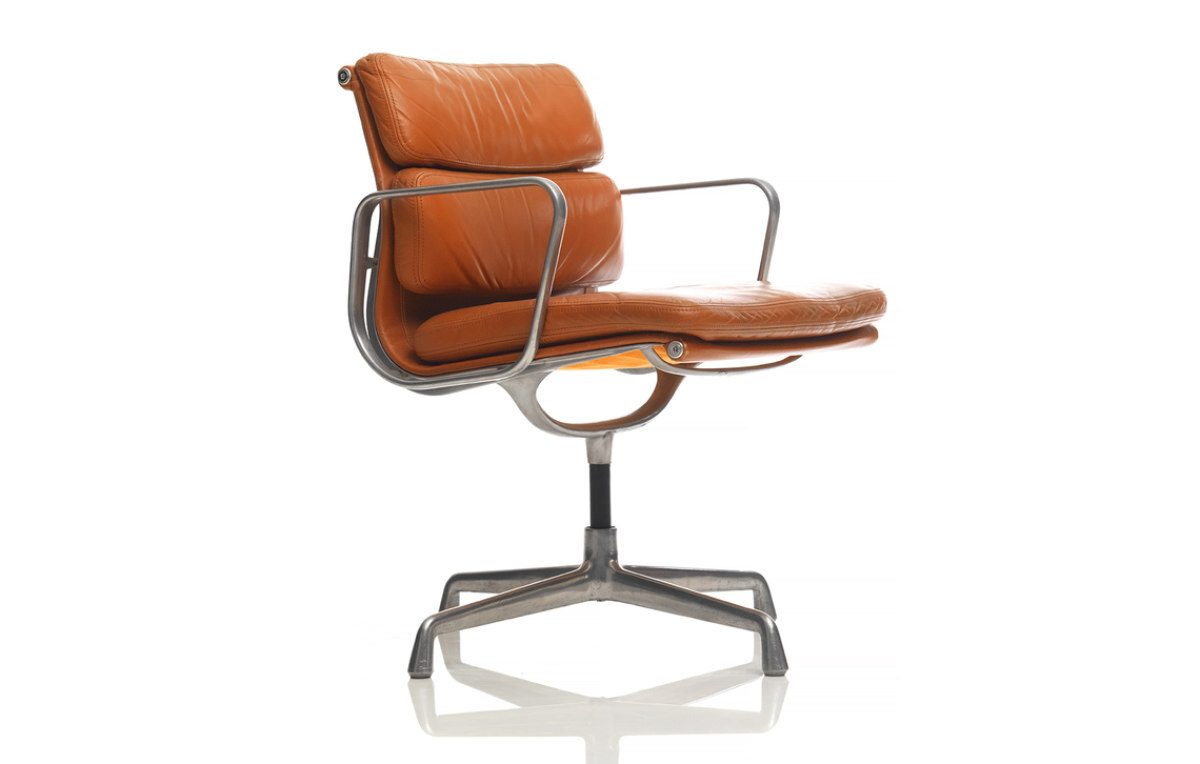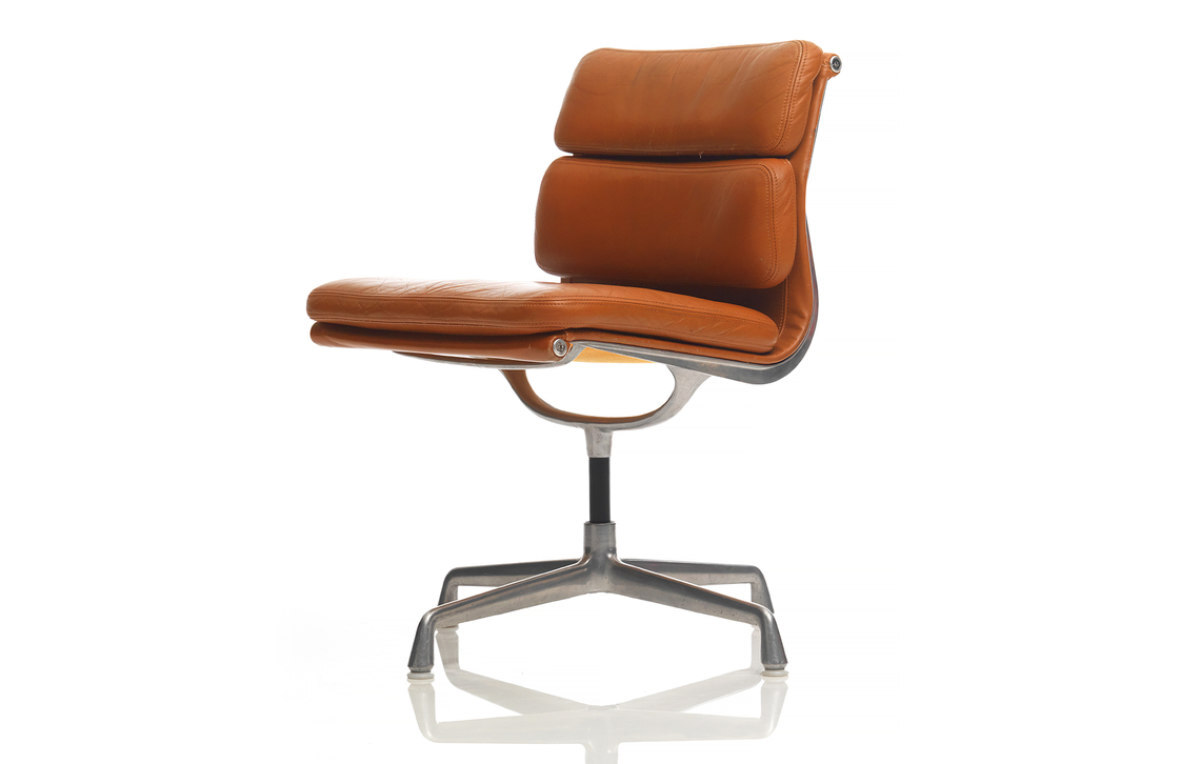Soft pad by Charles and Ray Eames
General info
Charles Ormond Eames, Jr (1907–1978) and Bernice Alexandra "Ray" ( néé Kaiser) Eames (1912–1988) were American designers who worked in and made major contributions to modern architecture and furniture. They also worked in the fields of industrial and graphic design, fine art and film.
Charles Eames briefly studied architecture at Washington University in St. Louis on an architecture scholarship. After two years of study, he left the university. Many sources claim that he was dismissed for his advocacy of Frank Lloyd Wright and his interest in modern architects. The university reportedly dropped him because of his "too modern" views.[1] Other sources, less frequently cited, note that while a student, Charles Eames also was employed as an architect at the firm of Trueblood and Graf. The demands on his time from this employment and from his classes led to sleep-deprivation and diminished performance at the university. While at Washington University, he met his first wife, Catherine Woermann, whom he married in 1929. A year later, they had a daughter, Lucia Jenkins.
In 1930, Charles began his own architectural practice in St. Louis with partner Charles Gray. They were later joined by a third partner, Walter Pauley.
Charles Eames was greatly influenced by the Finnish architect Eliel Saarinen (whose son Eero, also an architect, would become a partner and friend). At the elder Saarinen's invitation, Charles moved in 1938 with his wife Catherine and daughter Lucia to Michigan, to further study architecture at the Cranbrook Academy of Art, where he would become a teacher and head of the industrial design department. In order to apply for the Architecture and Urban Planning Program, Eames defined an area of focus—the St. Louis waterfront. Together with Eero Saarinen he designed prize-winning furniture for New York's Museum of Modern Art "Organic Design in Home Furnishings" competition.[3] Their work displayed the new technique of wood moulding (originally developed by Alvar Aalto), that Eames would further develop in many moulded plywood products, including chairs and other furniture, splints and stretchers for the US Navy during World War II.
In 1941, Charles and Catherine divorced, and he married his Cranbrook colleague Ray Kaiser, who was born in Sacramento, California. He then moved with her to Los Angeles, California, where they would work and live until their deaths. In the late 1940s, as part of the Arts & Architecture magazine's "Case Study" program, Charles and Ray designed and built the groundbreaking Eames House, Case Study House #8, as their home. Located upon a cliff overlooking the Pacific Ocean and hand-constructed within a matter of days entirely of pre-fabricated steel parts intended for industrial construction, it remains a milestone of modern architecture.
Charles Eames died of a heart attack on August 21, 1978 while on a consulting trip in his native Saint Louis, and was buried in the Calvary Cemetery there. He now has a star on the St. Louis Walk of Fame.
Ray-Bernice Alexandra Kaiser Eames (December 15, 1912 – August 21, 1988) was an American artist, designer, and filmmaker. Along with her husband Charles Eames she is responsible for groundbreaking contributions in the field of architecture. furniture design, industrial design, manufacturing and the photographic arts. She was born in Sacramento, California to Alexander and Edna Burr Kaiser, and had a brother named Maurice. She spent her early childhood years with her parents in their apartment, and then moved to a Bungalow outside of the town. Her parents taught her the quality of enjoyment which later led to inventions in furniture design and toys. Her parents also instilled the value of enjoyment of nature in her. After having lived in a number of cities during her youth and after her father's death, in 1933 she graduated from Bennett Women's College in Millbrook, New York, and moved to New York City, where she studied abstract expressionist painting with Hans Hofmann. She was a founder of the American Abstract Artists group in 1936 and displayed paintings in their first show a year later in 1937 at Riverside Museum in
Manhattan. One of her paintings is in the permanent collection of The Whitney Museum of American Art. She lived alone in New York City until she was called home to be with her ailing mother before she died in 1940.
In September 1940, Ben Baldwin, an architect and friend, recommended she began studies at the Cranbrook Academy of Art in Bloomfield Hills, Michigan. She learned a variety of arts, not limiting herself to abstract painting. She worked with Harry Bertoia, Eero Saarinen, Charles Eames and others on the display panels for the exhibition "Organic Design in Home Furnishings" at Museum of Modern Art.[10] Ray married Charles Eames the following year in 1941. Settling in Los Angeles, California, Charles and Ray Eames would lead an outstanding career in design and architecture.
The design process between Ray and Charles was strongly collaborative. After marriage the couple moved to California to continue their molded plywood furniture design and, in a later period, plastic. The graphic and commercial artwork can be clearly attributed to Ray, she designed twenty-six cover designs for the journal Arts & Architecture during 1942 to 1948, and a major part of the Eames furniture advertisements at Herman Miller (since 1948).
In the late 1940s, Ray Eames created several textile designs, two of which, "Crosspatch" and "Sea Things", were produced by Schiffer Prints, a company that also produced textiles by Salvador Dalí and Frank Lloyd Wright. Two of her textile patterns were distinguished with awards in a textile competition (organized by MoMa). She worked on graphics for advertising, magazine covers, posters, timelines, game boards, invitations and business cards. Original examples of Ray Eames textiles can be found in many art museum collections. The Ray Eames textiles have been re-issued by Maharam as part of their Textiles of the Twentieth Century collection.
After Charles' death in 1978, the Eames Office was disbanded. Ray Eames worked on several unfinished projects (e.g. a German version of the Mathematica exhibition), was a consultant to IBM, published books, and administered the Eames archive and estate.
Ray Eames died in Los Angeles in 1988, ten years to the day after Charles. They are buried next to each other in Calvary Cemetery in St. Louis.
In the 1950s, the Eameses continued their work in architecture and modern furniture design. As with their earlier molded plywood work, the Eameses pioneered technologies, such as fiberglass furniture, plastic resin chairs, and the wire mesh chairs designed for Herman Miller. From the beginning, the Eames furniture has usually been listed as by Charles Eames. In the 1948 and 1952 Herman Miller bound catalogs, only Charles' name is listed, but it has become clear that Ray was deeply involved and was an equal partner with her husband in many projects. In August 2005 Maharam fabrics reissued Eames designed fabrics; Sea Things (1947) pattern and Dot Pattern. Dot Pattern was conceived for The Museum of Modern Art’s “Competition for Printed Fabrics” in 1947. The Eames fabrics were mostly designed by Ray, as were the Time-Life Stools. In 1979, the Royal Institute of British Architects awarded Charles and Ray with the Royal Gold Medal. At the time of Charles' death they were working on what became their last production, the Eames Sofa, which went into production in 1984.
The chairs we sell
The chairs and leather cushions are in good vintage condition. The chairs show some normal wear.

